In this article, we will discover how to use shiny metal buckets to plant your water plants in. Of all the water features that I have discussed from bubble fountains, water containers, planting marginals, bog plants in containers, this is the simplest.
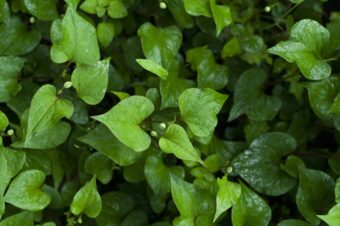
All you need is a bucket and a plant. Shiny metal buckets that can hold water is a wonder in the garden, as they have reflective surfaces that suggest it contains water and it shows it at its best. So what is not to like about having a water plant in a metal container.
MATCH IT WITH OTHER CONTAINERS
A group of matching containers that are of different sizes and shape that a planted with marginals and bog plants, make a beautiful display that looks good in an informal, cottage-style garden. To add extra pizazz, try growing outside along a back door or by an outbuilding.
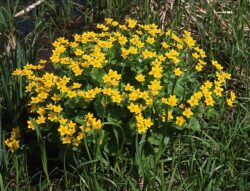
To show off the display it needs a good background, such as in front of a pond, a large glass door or a white wall, where sunlight will be reflected between the metal surfaces and the water within. Place the metal container on a base of gravel, cobbles or pebbles to add to the appeal of the display.
Suitable plants to include in your display is something that grows naturally in shallow water or those boggy plants that like moisture-retentive composts.
To make a stunning display, team up containers with a single, large specimen plant noted for its leaves, with others in groups of smaller flowering plants. Water plants, in general, look good together but for a display of greater impact allow one colour only, say red, to run through the scheme in each container. In this way, time will be saved as it will be easier to link the display together visually since they are already in matching containers.
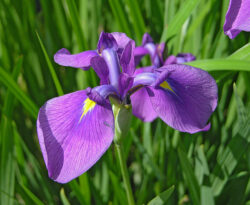
To have the most impact choose compact plants of a slow-growing genus with a long flowering season. This is difficult to do as in practice for water plants little fall into this category. It is best instead to choose plants that are in flower for the longest and are suitable to be replanted in the dampest part of the garden after one season in the container, or even better to divide and replant them in the same container the following spring. They are not long term displays in containers.
PLANTING A METAL TROUGH
Fill a good length, shiny metal through with good quality, moisture-retentive multipurpose compost. Do not add any gravel to improve drainage, as the through is too shallow and only water-loving plants will be used.
Choose a mixture of tall, upright plants that have leaves of contrasting shapes, textures and colours, but roughly of the same height. Plants such as Mimulus luteus, Ajuga reptans ‘Braunherz’, Lobelia cardinalis and Phalaris arundinacea ‘Picta’. On the left-hand side plant, a Mimulus luteus, next plant a Phalaris, then next to that plant a Lobelia cardinalis. Next to that plant another Mimulus and finally another Phalaris. Knock them out of their pots and plant them straight in the compost, all in a straight row.
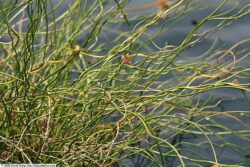
In front of the trough at 3 equal spaces, plant the Ajuga reptans, a low spreading plant. One at the front at the centre and the other at each end of the container. Your display should be looking quite stunning.
Use a narrow trowel and some more compost to fill and settle the plants down. Add more water, leaving the mixture wet but not soggy. Keep it like that as these plants hate to be dry at all.
WHAT PLANTS CAN BE USED IN WATER PLANT DISPLAY IN METAL DISPLAYS?
The following plants can be used: Cyperus (Umbrella plant), Caltha palustris (Marsh Marigold), Filipendula ulmaria ‘Aurea’ (Golden Dropwort), Hosta, Iris laevigata (Japanese Water Iris). Iris versicolor, Lysimachia nummularia (Creeping Jenny), Lysimachia punctata (Loosestrife), Juncus effusus ‘Spiralis’ (Corkscrew Rush), Mentha aquatica (Water Mint), Mimulus (Monkey Flowers), Scirpus zebrinus (Zebra Rush), Typha minima (Miniature Bulrush), and Zantedeschia aethiopica (Arum Lily)
PLANTING AN ASTILBE IN A METAL BUCKET
In a tall, narrow, metal flower bucket plant a tall, graceful plant such as Astilbe. You can either leave it in their pots they come in or you can remove it and plant it directly into the bucket. It does not matter as it will only be in place in the bucket for one summer, as it will soon get too big.
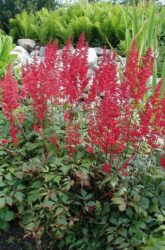
First, fill the base of the metal bucket with gravel to act as a ‘height’ to keep it upright. It will also provide some drainage, which is very important for the plant within.
Position the plant on top of the gravel bed, so that it rests 2.5cm below the rim of the metal container inside its original container. Alternatively, add enough multipurpose compost that reaches 2.5cm below the rim and then plant the Astilbe in this. You will have now an impactful plant in a shiny metal bucket.
GROWING INVASIVE PLANTS IN A BUCKET
Some plants that are invasive if planted in the ground, can be grown in a bucket. This will not only keep them within bounds, but it is also the easiest way to give them the right conditions to enjoy them fully, When eventually the plant gets too big, you can tip them out and divide them in early spring. Repot a healthy division back into a new mix in the same container.
Place a layer of clean gravel in the bottom of a watertight, shiny metal bucket to give it a firm base and to help support the plant within. Place a plant like Houttuynia cordata ‘Chameleon’ in its own container into the bucket. Do this if it is large but on the other hand, if the plant is small fill the bucket with a good quality multipurpose compost and plant as normal.
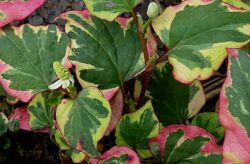
You will now have astilbe in a bucket, an invasive plant in a metal bucket and various plants in a metal trough. If you arrange the three filled containers close together to create a spectacular metal bucket theme. Place them near a reflective surface to show them off and to complete the look.
CONCLUSIONS
In this article, we have discussed 3 different ways to create a stunning display of water plants in a shiny, metal container including a metal bucket. You can have astilbe in a metal bucket various plants in a metal trough and an invasive plant in a metal bucket. All three will complement each other, especially if they are grouped together and near a reflective surface like a glass door.
They are very easy to do and can complement other water features to give an extra touch.
If you have any comments or question on this topic, please do so in the comment box below.
Happy growing water plants in a metal container.


